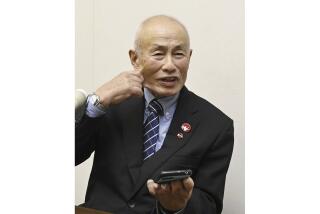After 50 Years’ Silence, Credit Is Due Nobel Peace Laureate Martyred by Nazis
- Share via
In the official calendar of the Nobel Foundation there is the following entry: “Peace Prize, 1936, The Prize for 1935: von Ossietzky, Carl, Germany, Journalist (i.a. de Weltbuhne), Pacifist, born 1889, died 1938.” What does not appear from this brief description is that the recipient, an outspoken opponent of the Hitler regime, was at the time of the award being held prisoner in a Nazi concentration camp.
There is more to the story, and with it perhaps a modest reminder that history does not always remember the most deserving of its children.
Ossietzky, who had served as an infantryman in World War I, became a prominent leader of the German peace movement during the 1920s. In 1924, he was appointed co-editor of the radical weekly de Weltbuhne, and became editor-in-chief in 1927.
He was, at least in the Germany of his time, a kind of political maverick--an internationalist, pacifist, socialist, devoted to democracy and freedom of expression, hostile to the emerging totalitarian movements of the right and left. His literary style was described by contemporaries as trenchant, witty and elegant.
In March, 1929, he published an article critical of the clandestine rearmament of Germany and was prosecuted under a 1914 espionage act on a charge of disclosing military secrets. He was tried in a closed hearing, convicted and sentenced to 18 months in prison on Nov. 22, 1931. After serving seven months, he was released under a general amnesty on Dec. 22, 1932.
Refusing to go abroad, as his friends had urged him, he returned to his newspaper and concentrated his energies in an unrelenting opposition to the rising threat of the Nazi Party. On the night of the Reichstag fire, Feb. 27, 1933, he was arrested and taken to Sonnenburg concentration camp. Later, he was moved to the camp at Papenburg.
His health undermined by the brutalities of his Nazi guards, he contracted tuberculosis and was transferred to a series of hospitals where he lived “under police supervision.” There he remained, effectively a prisoner of the Gestapo until he died, unrepentant, on May 4, 1938.
Although Ossietzky’s name had been discussed in 1934, a formal proposal nominating him for the peace prize was not submitted until 1935. The selection committee, composed of members of the Norwegian parliament, was unable to reach agreement, and the 1935 award was reserved, or postponed for a later time.
During the discussions of the committee in 1936, two of its members--the Norwegian foreign minister and a former prime minister--resigned because of the political complications that were certain to follow any award to Ossietzky. They were replaced by alternate members.
On Nov. 23, 1936, the committee announced its decision to award the peace prize for 1935 to Ossietzky and the prize for 1936 to the Argentine statesman, Carlos Saavedra Lamas.
While the award to Ossietzky was immediately applauded in most democratic circles around the world, the German reaction was predictably one of furious indignation at what could only be regarded as a calculated repudiation of fascism. Diplomatic relations between Norway and Germany were strained, and the Nazi press indulged its accustomed talent for crude invective. The very name of the prize recipient became a term of opprobrium in the demonology of Nazi Germany--in July of 1937, the official newspaper of the SS attacked the physicist Werner Heisenberg by calling him “the Ossietzky of physics.”
By a decree of Jan. 31, 1937, German nationals were forbidden to accept any Nobel prizes, which up to that time had been awarded more frequently to Germans than to any other nationality.
Ossietzky never received his award or the money that accompanied it.
And now, a half century after his death, even his name is unknown to all but a handful. It is almost as if his life, forfeited in the fight against Hitlerism, has disappeared with hardly a trace beneath the rubble of the Third Reich.
One inevitably wonders why the story of Carl von Ossietzky is not more widely known.
Part of the answer may lie in the realization that, all too often, the deeds of the past are best remembered when they serve the institutional needs of the present. Nation-states have their patriots to remember, organized churches their saints and martyrs and political parties their own pantheon of past leaders.
Ossietzky quite simply slipped through the cracks. He did not fit comfortably within any of the major institutions of his culture. An individualist, he was never a mainstream social democrat and he was anathema to the communists. Liberals and conservatives alike viewed him as a radical. He was opposed to militarism and nationalism in a world soon to be dominated by both. In the catastrophic events that ensued, it is understandable perhaps that the accomplishments of one man would be crowded off the stage.
It is also possible, albeit a little ironic, that his opposition to Nazism may have come too early in the game for him to be viewed in retrospect as a hero of the German resistance against Hitler.
Whatever the reasons, we are left with the image of a lone individual human being who took a principled stand against a great evil, who paid the price and, after a brief moment of reknown as a symbol, received obscurity as his award.
On Dec. 12, 1936, a group of prominent American cultural and political leaders met in New York to pay tribute to Ossietzky, the man and symbol. Albert Einstein, himself a Nobel laureate, said it best when he referred to Ossietzky as, “the most admirable of the few outstanding personalities of Nazi Germany who have put the interest of humanity above that of national egotism.”
More to Read
Sign up for Essential California
The most important California stories and recommendations in your inbox every morning.
You may occasionally receive promotional content from the Los Angeles Times.










